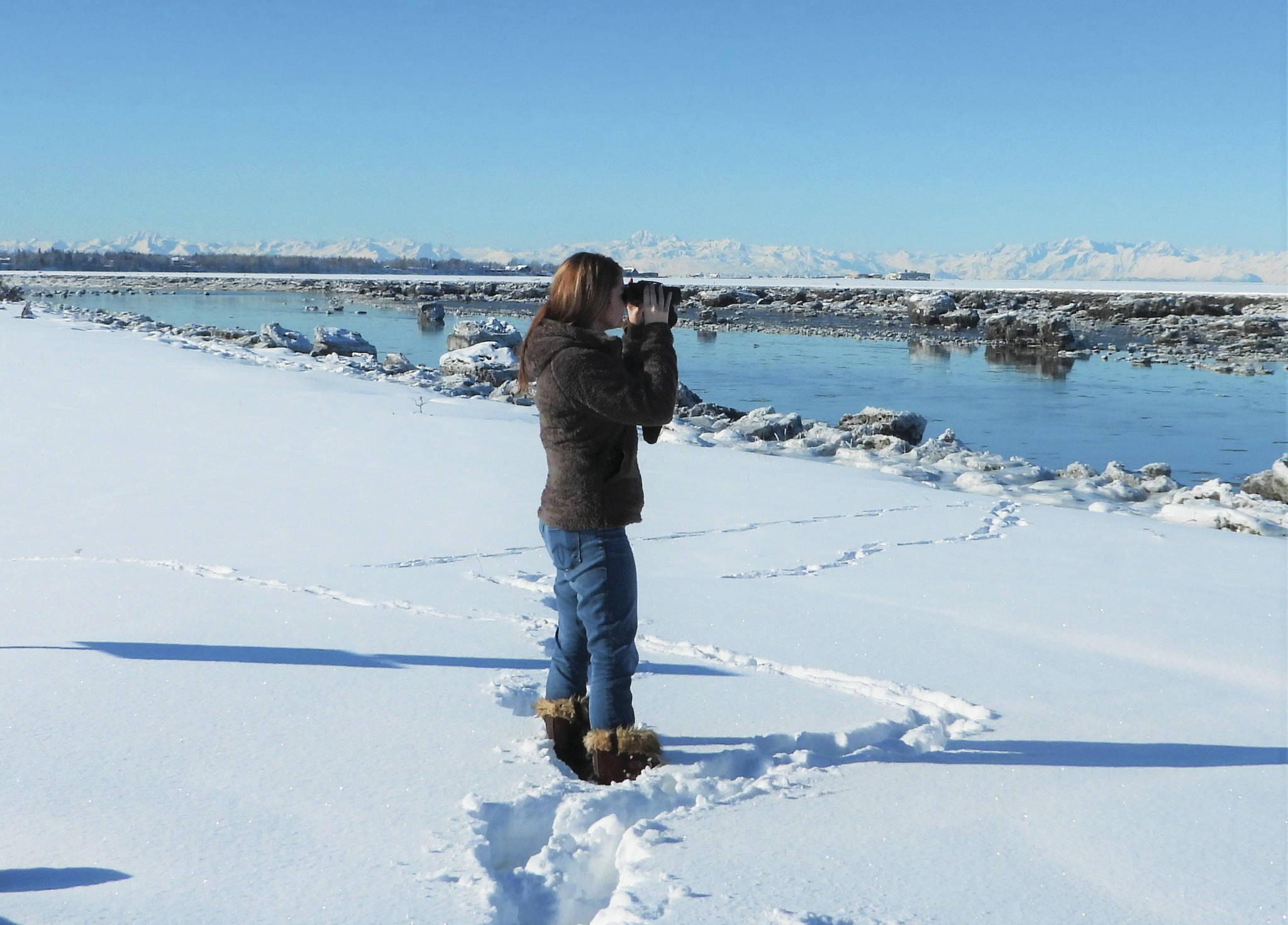Many people may not realize it, but some beluga whales spend the winter along the Cook Inlet coast from Kenai southward. They even travel up the Kenai River in search of food. Cook Inlet beluga whales disperse throughout Cook Inlet in the winter as opposed to the summer months when they tend to be concentrated in the upper Inlet. In particular, they are attracted to the coast near the Kenai river area.
In the past they used this area and further south all year long, but recent evidence suggests they only use the area from September until May now. National Oceanic and Atmospheric Administration Fisheries, the agency responsible for the management of this endangered population of beluga whales, relies heavily on observations from the public to fill in the gaps on where belugas are and when to understand why the species continues to decline. Belugas were seen in the Kenai River on Dec. 1, 2020, and near the mouth of the Kenai River on Dec. 30, 2020. On Jan. 2, 2021, six to 10 adult belugas were reported to NOAA offshore about 5 miles south of Ninilchik. On Jan. 4, Bud and Sammy Crawford of Kenai were walking the beach about 2 miles south of the Kenai River when they spotted more than 25 beluga whales traveling south, spread out about a quarter mile.
“After 40 years of living on the beach on Cook Inlet that was the most outstanding sighting of belugas I’ve ever seen,” said Bud Crawford.
The couple also advised a neighbor told them these belugas had been in the Kenai River earlier. On Jan. 28, 11 belugas were reported about a mile north of Kenai headed south. If anyone sees belugas along the coast or in one of the rivers, please report them on the Belugas Count! Facebook website at https://www.facebook.com/BelugasCount.
Cook Inlet beluga whales have been listed as endangered since 2008. The most recent NOAA Fisheries population survey indicated a continuance of their decline with an estimate of only 279 whales when last surveyed in June 2018. Cook Inlet belugas are geographically isolated from other Alaska beluga stocks and remain in the inlet year-round. Cook Inlet belugas face many threats, including habitat loss and degradation, prey reduction and anthropogenic (human made) noise.
Monitoring Cook Inlet belugas and understanding their challenges are critical to recovery efforts for this endangered species. NOAA supports multiple research and monitoring efforts for Cook Inlet belugas, including the Alaska Beluga Monitoring Partnership (AKBMP – www.akbmp.org), Belugas Count!, and the Cook Inlet Photo ID Project (https://www.cookinletbelugas.com/), all of which provide information about beluga presence and behavior that biologists at NOAA Fisheries can use.
One of the challenges for NOAA to understand what is limiting this population of belugas is to determine what prey are most important for these whales, especially in winter. In the spring and summer belugas rely on eulachon and salmon but in the winter much less is known about their diet. The Kenai River has been identified as an important foraging site for the belugas, especially in the winter. However, outside of salmon, there is limited information identifying prey species. Are the belugas targeting flounder in the river? Or outgoing smolt? Are juvenile pollock along the beaches near the river being utilized?
To this end, Verena Gill with NOAA Fisheries has initiated a study entitled “Using environmental DNA (eDNA) to identify temporal prey availability in the Kenai River for the endangered Cook Inlet beluga population.” Sampling for fish in the Kenai is challenging, labor intensive and may miss many of the species inhabiting the river. However, collecting water to look for fish DNA signatures is efficient and provides a more comprehensive sampling technique.
This pilot study seeks to collect and analyze water samples from the Kenai River from November 2020 through April 2021 from the water surface and at depth. DNA analysis of the samples will provide prey type and abundance for this critical time period. These data will help NOAA build a foraging model for the Cook Inlet belugas that better identifies their dietary needs.
One or two times each month, Dr. Debbie Boege Tobin, Professor of Biology at the Kachemak Bay Campus of Kenai Peninsula College – University of Alaska Anchorage, leads a team of field researchers, including several students from the Kachemak Bay and Kenai River campuses, to the Kenai River to collect samples at high tide at the City Docks and the Warren Ames Bridge. These samples are then taken back to KBC in Homer where the DNA is filtered out and sent to Dr. Kim Parsons of NOAA’s Northwest Fisheries Science Center for genetic analysis. Dr. Alison Gardell, formerly of the KPC Kenai River Campus, initially provided UAA grant-funded equipment and opportunities for Kenai students to get involved in this project; she continues as a consultant in her new position at the University of Washington-Tacoma.
The official spring beluga monitoring season starts March 15 and runs through May 15 and we could use volunteers. If anyone is interested they can sign up on the Alaska Beluga Monitoring Partnerships website at www.AKBMP.org. For the Kenai Peninsula, monitoring sites are on the Kenai and Kasilof Rivers and we have several volunteers from the Homer area.
If this project is successful for the Kenai River, NOAA hopes to expand eDNA research to other sites in Cook Inlet to better identify important prey species for these highly endangered beluga whales.
Teresa Becher a a student at the University of Alaska Anchorage studying Natural Sciences with a pre-veterinary focus. Dr. Debbie Boege Tobin assisted her in editing.


